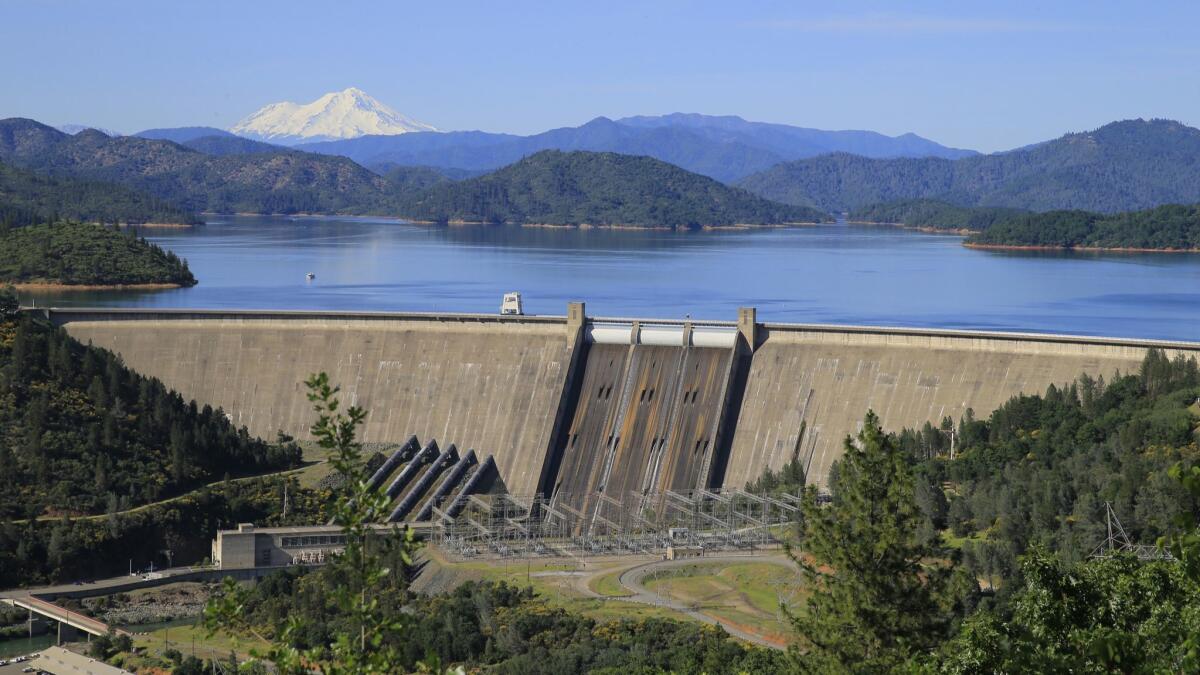How California is defying Trump’s environmental rollbacks

- Share via
California is building walls at its borders — they’re just not the kind President Trump has in mind.
As the Trump administration continues its assault on environmental regulation, state officials are throwing up legal barriers to some high-stakes attacks.
They are preparing to strengthen safeguards for waterways that are about to lose federal protections in a major rollback of the Clean Water Act.
They are refusing to issue permits the federal government needs to build a controversial dam project that would drown portions of a Northern California river renowned for its wild trout fishery.
And they can use state water quality standards to limit Washington’s ability to boost irrigation supplies for Central Valley agriculture by relaxing federal safeguards for endangered fish.
“The state can stand up against the federal government on every single one of those issues,” said Noah Oppenheim, executive director of the Pacific Coast Federation of Fishermen’s Assns.
Armed with some of the strongest environmental laws in the nation, California has been a leader in the resistance to the Trump administration.
Trump administration unveils major Clean Water Act rollback »
As governor, Jerry Brown repeatedly clashed with the White House over Trump’s policies on climate change and vehicle fuel economy standards. Since taking office in January, Gov. Gavin Newsom has continued the fight.
That became clear one week after Newsom’s inauguration, when representatives of three state agencies reiterated that the dam project is illegal under California law.
The $1.3-billion proposal would raise the 602-foot-tall Shasta Dam near Redding another 18½ feet. Doing so would increase the storage capacity of Shasta Lake, California’s largest reservoir, by roughly 14%.
But it would inundate a stretch of the McCloud River, which is protected under California’s Wild and Scenic Rivers Act.
“We are prohibited by state law” from permitting the Shasta project, said Andrew Sawyer, assistant chief counsel of the State Water Resources Control Board. The water board, the California Department of Fish and Wildlife and the State Lands Commission outlined their objections Jan. 14 in letters to the Westlands Water District in Fresno, the state’s largest irrigation district and primary backer of the proposal.
Westlands did not respond to a request for comment.
California authorities say the Shasta plan is clearly subject to a section of the 1902 Reclamation Act that requires federal irrigation projects in the West to comply with state laws that relate “to the control, appropriation, use, or distribution of water used in irrigation.” Exceptions can be made only if Congress directly exempts a project from that mandate.
In 2017, the GOP-dominated House approved legislation that attempted to do that for operations managed by the federal Central Valley Project, including Shasta Dam.
But concern for states’ rights killed the bill in the Senate, where the proposal never got out of committee. And with Democrats now in control of the House, any similar efforts in the new Congress are all but doomed.
On another front, the state water board is expected to vote Tuesday on a package of rules that would counter Trump administration plans to cut wetlands protections.
In December, the U.S. Environmental Protection Agency gave notice that it is dropping Obama-era regulations that broadened the Clean Water Act’s coverage of wetlands and seasonal streams, which are common in California and the arid West.
The law allows states to adopt regulations that are more stringent than the federal standards. California’s water board has been considering tougher wetlands protections for more than a decade, ever since the U.S. Supreme Court issued a set of decisions that left authorities confused about which waters were covered under the act.
The board’s efforts have taken on a new urgency in the wake of the EPA’s move.
“The threat of the Trump administration rollback has really amplified interest and concern about a need for developing state-level protection,” said Julia Stein, a supervising attorney at UCLA’s environmental law clinic.
The Sacramento-San Joaquin Delta, the center of California’s water system, is another Trump-California battleground.
Westlands and other San Joaquin Valley irrigation districts have long fought protections for endangered fish that limit water exports from the delta. Under Trump, they have a major ally at the Interior Department: acting Secretary David Bernhardt, a former lobbyist for Westlands who is in line to succeed Ryan Zinke in the agency’s top post.
Last month, the U.S. Bureau of Reclamation released documents that justified loosening the restrictions on the grounds that habitat restoration and other measures would help imperiled populations of delta smelt and migrating salmon.
Federal fish and wildlife biologists have until this summer to issue a new set of delta export rules. If the regulations are weakened, environmentalists will almost certainly mount a challenge in the courts, which blocked a similar effort by the George W. Bush administration.
California has its own endangered species law, but it is unclear whether those protections fit into the category of state laws that the federal reclamation bureau must adhere to.
Still, state standards for salinity levels in the delta and for the volume of water that flows through delta habitats to the ocean will restrict the Trump administration’s ability to boost exports, said Holly Doremus, an environmental law expert at UC Berkeley.
Another leverage point lies in the linkage of state and federal water operations in the delta. The California Department of Water Resources can, for example, refuse to let federal water managers use the state-owned California Aqueduct to convey delta supplies if the state believes the water shipments would hurt protected fish.
“The state retains primary regulatory authority over its water, period,” Doremus said. “It has always been bluster for the feds to run around saying … that they are going to make California do whatever.”
Twitter: @boxall
More to Read
Sign up for Essential California
The most important California stories and recommendations in your inbox every morning.
You may occasionally receive promotional content from the Los Angeles Times.











